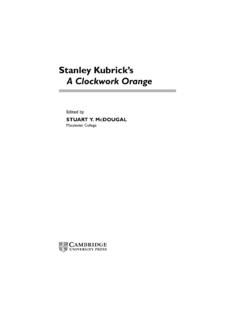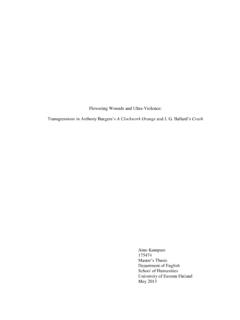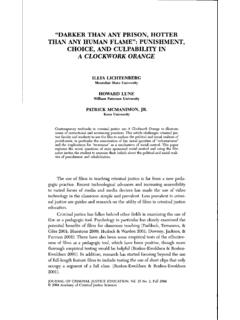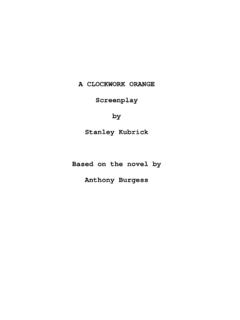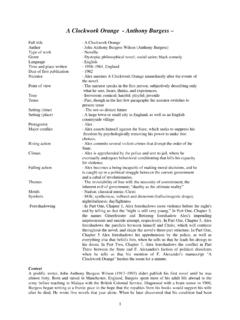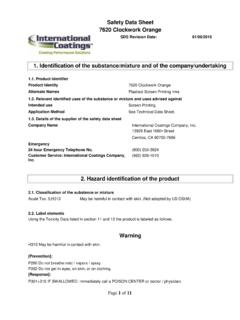Transcription of A key for a Clockwork Orange (Winter 2016) - Lobster
1 A key for a Clockwork OrangeGarrick AlderPreambleAnthony Burgess s 1962 novel A Clockwork Orange became infamous after the 1971 film adaptation by Stanley Kubrick. The director s withdrawal of the film from UK circulation inspired decades of mythologising about it, adding to its notoriety and aura. Critical arguments about the role of violence in the suppression of the film have never been convincing. Such violence as occurs in the film is confined to the first third, and is heavily orchestrated and balletic. It is hard now to imagine that the violence of Kubrick s film was more alarming to viewers in the 1970s than that of Sam Peckinpah s blood-spattered Straw Dogs, released the same year.
2 Kubrick s adaptation is usually classified as science-fiction, like its parent novel. But this too has never seemed really plausible. There is nothing in the film that says this is taking place in some future Britain. Quite the opposite. Its plastic miniskirts, thigh-high boots, fly-away collars and above all its gaudy interior chic (right down to the off-the-shelf paintings from Woolworth s, seen in Alex s home) all show that this was a contemporary Britain, or at least one not far removed from it. The vision of the future provided by Kubrick in 2001: A Space Odyssey is convincingly coherent by contrast, and very high-tech.
3 1 1 This brief summary could be greatly expanded. The car stolen by Alex is not some futurist prop, but a real car produced in 1969, and Alex is seen using it to force a VW Beetle off the road; the displays in the record shop scene show albums by Pink Floyd ( Atom Heart Mother ), Crosby Stills Nash and Young ( Deja Vu ) and Neil Young ( After the Gold Rush ), all released in 1970; and, conclusively, a copy of the Daily Telegraph refers to the previous month s Audited Bureau of Circulations figures as August 1970 . In the conditioning scene, in which A Clockwork Orange s anti-hero Alex is being brainwashed into renouncing violence, the head scientist (Dr Brodsky) says the following lines: Very soon now the drug will cause the subject to experience a death-like paralysis together with deep feelings of terror and helplessness.
4 One of our earlier test subjects described it as being like death, a sense of stifling and drowning [..] These lines are not from Burgess s novel, which Kubrick used as the basis of his screenplay (encouraging actors to ad-lib around the book s dialogue and writing it up afterward). They are plainly related to quoted speech in a newspaper story that appeared while Kubrick was making his film. [The drug produces] sensations of suffocation and drowning. The subject experiences feelings of horror and terror, as though he were on the brink of death. The story in question appeared in the San Francisco Chronicle on 18 October 1970 (the month after Kubrick began filming), and concerned human conditioning experiments then taking place at California Medical Facility at Vacaville, using violent prisoners as subjects.
5 The speaker was Dr Arthur Nugent, in charge of the program, and the drug was anectine, a strong muscle relaxant still in use today in some surgical settings. The effect on the human guinea-pigs was to halt all muscular actions, voluntary or involuntary, causing temporary paralysis and preventing them from even breathing, rendering them totally reliant on external assistance in order to survive. While incapacitated and terrified, the prisoners would be scolded harshly by psychologists, with the intent that this would condition the prisoners into renouncing crime due to a learned association with their ordeal.
6 Dr Nugent told the Chronicle: Even the toughest inmates have come to hate and fear the drug. I don t blame them. I wouldn t have one treatment myself for the world. Kubrick s dystopian future wasn t science-fiction at all. It wasn t even the novelThere have been persistent rumours that Anthony Burgess s novel (published by Heinemann, London, in May 1962) was in some way related to espionage. These rumours were given the proverbial shot in the arm with the 2002 publication of Roger Lewis s scurrilous biography, entitled simply Anthony Burgess (published by Faber and Faber).
7 2 Lewis engages in much speculation but the most substantial material concerns what Lewis was told when he made contact with an intelligence officer: You realise, said the spook, as we sat on a bench in Berkeley Square, opposite Maggs Bros. Ltd, by appointment to Her Majesty the Queen, purveyors of rare books and manuscripts, that the capitalised lines on page twenty-nine of A Clockwork Orange give the HQ location of the psychotronic warfare technology? The lines in question refer to the words on a pennant in Alex s bedroom (described in part one, chapter three), a souvenir of his time in correctional school, and they read: SOUTH 4; METRO COR-SKOL BLUE DIVISION; THE BOYS OF ALPHA.
8 Lewis remarks: It does sound like an encryption. But of what precisely? He goes on: It was patiently explained to me [by the spook] that if you look at a map of America, then Utah, Colorado, Arizona, and New Mexico are the only states with a right-angled four-corner conjunction ( ) and that there is a military reservation to the SOUTH . It runs north into New Mexico and is based around the metropolitan area called El Paso. It is a training school ( SKOL Russian). The Navy ( BLUE DIVISION ) were initially in charge of the technology. Analysing, isolating, and interfering with the ALPHA wavelengths of the human collective unconscious was part of the set-up.
9 The name of the establishment is Fort Bliss. The word 2 Blake Morrison, reviewing Lewis s biography in The Guardian, mentions that he had been told the same thing by a retired security officer. See < >.bliss appears on page twenty-nine of Burgess s novel no less than six times. Lewis s reaction to this information is expressed in his description of himself polishing my glasses with the fat end of my tie and looking simultaneously inscrutable and bewildered. Mr Lewis can t really be blamed here. He was, after all, writing a biography of the writer, not researching Cold War espionage.
10 But he had been set a puzzle, if only he had realised it. And a little more examination would have led him toward an unexpected message (once decrypted which is an inferential process of word-association and allusion, rather than a true decryption) is really there, but there s a huge problem. It's all lies and nonsense. Fort Bliss really is situated at the four-state square conjunction as specified, but it had no role whatsoever in any of the USA s mind control research. Nor is it connected to the US Navy, being a US Army post. The Navy s early mind control research, Project CHATTER, was abandoned in 1953 and had no formal relationship with the newer projects being undertaken by the CIA at the time A Clockwork Orange was published in 1962.

